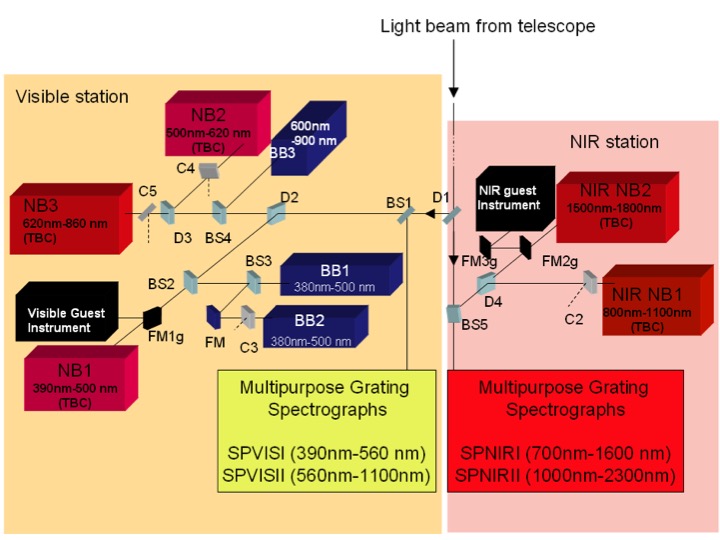Light Distribution System
The instruments are distributed in the Coudé room in two floors, the upper one dedicated to imagers and the lower one to grating spectrographs. The instrument layout takes into account the current design of each instrument type and the possibility of adding 2 additional guest instruments (one in the visible beam and one in the NIR beam). The light distribution system includes all mechanisms (with exchangeable beamsplitters/dichroics/mirrors/compensators needed to achieve flexible combinations) and the electronic cabinets for the instruments and light distribution mechanism.
The instrument layout has been designed for two cases: with the instruments static on a concrete slab (field rotation being provided by transfer optics) and with the instruments installed on a rotating platform (for alignment purposes and to compensate for image rotation). At the end of the Design Study, the former was found to be preferred, since it minimizes the number of elements to be rotated, giving more flexibility to the instruments design and for four future developments and upgrades.
The light coming from the telescope is shared among the following instruments channels:
- 3 visible broad band imager channels,
- 5 narrow band imager channels: 3 operating in visible wavelengths and 2 in the near-infrared,
- 4 grating spectrographs: 2 for the visible spectral range and 2 for the NIR. These spectrographs are versatile and can operate in different configurations, using adequate additional modules. There are four possible configurations:
- Long-slit Standard Spectrograph (LsSS),
- Multi-Slit Multi Wavelength SPectrograph equipped with an integral Field Unit (IFU-MSMWSP),
- Tunable Universal Narrow band Imaging Spectrograph (TUNIS), and
- Multi-channel Subtractive Double Pass, New Generation (MSDP-NG) .

The light distribution among the instruments (see Figure) is based on a division of the main beam coming from the transfer optics by a main dichroic D1 in two spectral stations: one for visible wavelengths and another for near-infrared. This division makes it possible to optimize the light flux transmission (after the beam separation, coating optics can be optimized for the selected spectral range at each station).
